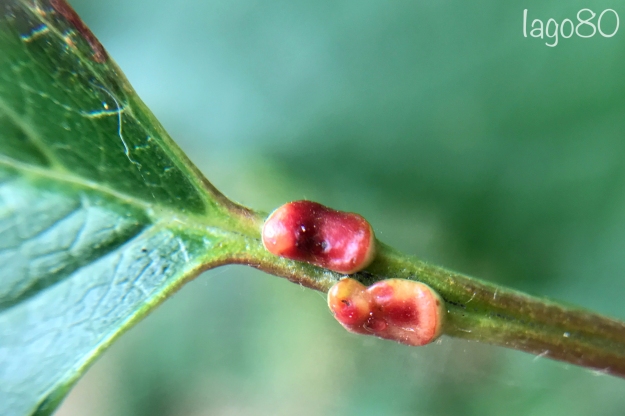Recently I have started studying plants far more carefully than before. This is not so much learning about the plant, as searching for galls on the plant. Some are easy to overlook such as the tight leaf edge rolls on Common Beech caused by the mite, Acalitus stenapsis:

Leaf edge roll caused by mite, Acalitus stenapsis
But in searching for galls, I have also started to notice other things.
At first I thought the red spots at the base of wild cherry leaves were galls. I now know they are glands, or ‘extrafloral nectaries’ to name them properly.

If the plant comes under attack from some kind of animal, the glands exude a scent which attracts different types of animal that will likely feed on the attacking pests. This knowledge would still be outside of my awareness were it not for my interest in, and search for, galls.
I also wouldn’t have found this Swallow-tailed Moth had I not been studying the underside of leaves for galls.

Swallow-tailed Moth (Ourapteryx sambucaria)
Nor indeed this wonderfully coloured and cryptically marked micro-moth:

Grapholita janthinana
My new-found interest in the small has led to the acquisition of an 10X magnification eye-glass to study my quarry better.

Two Knopper galls on acorn caused by gall wasp, Andricus quercuscalicis
To be honest, Knopper Galls do not really need magnification to appreciate them, but other galls are so tiny they really benefit from it:

Gall caused by asexual generation of gall wasp, Neuroterus anthracinus
This year on the patch I have been hunting fruitlessly, so far, for the Brown Argus Butterfly whose wing undersides resemble relatively closely the Common Blue:

Common Blue (Polyommatus icarus)
It is only by careful and close study that we truly get to know a species, sometimes taking such efforts to simply differentiate one species from another, such as the Dingy Footman from the Common Footman, Scarce Footman or others from the large eilema genus of moth.

Dingy Footman (Eilema griseola)
As a birder, I have become trained in noticing subtle movements, sounds, colours, and shapes at distance. But this summer, honing my skills in looking at things more closely and carefully, has opened up wonderful new worlds.

Male Long Hoverfly (Sphaerophoria scripta)


